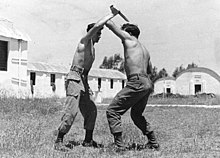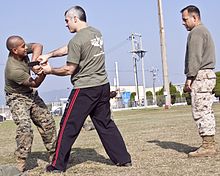Krav Maga

The clothing is based on the exercise clothing (including belt ) of the Japanese martial arts prevailing at the time .
Krav Maga ( Hebrew קרב מגע"Contact combat ") is a modern, eclectic Israeli self-defense system that preferably uses punching and kicking techniques , but also includes grip techniques , levers and ground fighting .
etymology
The name Krav Maga (קרב מגע) means "contact fight ", whereby krav (קרב) "Fight" and maga (מגע) "Contact" means.
history
Slovakia: self-defense against anti-Semitic thugs
The origins of Krav Maga go back to Imrich Lichtenfeld , who was born in Budapest (then in Austria-Hungary ) in 1910 and grew up in Bratislava (Pressburg) ( Slovakia ). Lichtenfeld was as boxers and wrestlers successful and had of his father, a policeman , jujitsu learned techniques. In the 1930s Lichtenfeld taught his fighting method for the first time in order to support the Jews living there against anti-Semitic attacks. Lichtenfeld emigrated from Slovakia in 1940. After an adventurous escape and a time in the British Army , he was allowed to enter Palestine in 1942 .
Palestine or Israel: close military combat
In what was then the British Protectorate of Palestine, he taught hand-to-hand combat in the Zionist underground organizations Haganah and Palmach , initially with British support . He changed his family name to the Hebrew form Sde-Or . After the establishment of the state of Israel in 1948, Lichtenfeld became a hand-to-hand combat instructor in the Israeli army .
Israel, later worldwide: self-defense system
After working in the army, Imrich Lichtenfeld adapted the military Krav Maga for police officers and civilians. For this purpose, the techniques were adapted to the non-military legal situation ( self-defense ). After Lichtenfeld's death in January 1998, several of his students claimed the title of “legitimate successor” in the field of civil Krav Maga. B .:
- Gabi Noah (Head of IKM International Krav Maga ),
- Haim Gidon (Head of the Israeli Krav Maga Association ),
- Eyal Yanilov (Head of Krav Maga Global ),
- Avi Moyal (Head of International Krav Maga Federation ),
- Haim Zut (Head of Krav Maga Federation Haim Zut ) and
- Yaron Lichtenstein (see: picture, right!).
| White |
|
|
| yellow |
|
|
|
|
||
| orange |
|
|
|
|
||
| green |
|
|
|
|
||
| blue |
|
|
|
|
||
| brown |
|
|
|
|
||
| black |
|
|
|
|
||
|
|
||
|
|
||
|
|
Krav Maga in the present
Today Krav Maga is taught worldwide. A distinction must be made between three target groups:
- Krav Maga for private individuals - for self-defense, de-escalation, stress resistance and with additional benefits for health / fitness
- Krav Maga for the security area or the police
- Krav Maga for the military
The goal for private individuals is to learn effective and simple methods to defend themselves against violence. For many, the fun and fitness factor is the decisive factor in exercising Krav Maga. In the USA, for example, Krav Maga is used heavily as a "fitness system".
In the security area and with the police, the main focus of training is: de-escalation, self-protection, operational tactics, personal protection, event protection, as well as discharge and control techniques.
Krav Maga in the civil sector
Krav Maga is characterized by simple techniques. Natural and instinctive reactions are taken into account in the system and integrated in a meaningful way. This means that Krav Maga can be learned relatively quickly. According to its self-image, Krav Maga is not a sport , but a pure self-defense system. There are no competitions. The right reaction to stress is particularly trained. A lot of space is given to the right tactics in dangerous situations. For example, the recommendation is to keep your own hands at chest height in order to be able to use them quickly for defense or counterattack. In addition, it is also about recognizing dangers at an early stage and using skillful behavior to avoid the conflict or to disarm the enemy.
Due to the historical development, the martial arts background of many representatives and the orientation towards principles and less according to rigid techniques, various organizations and interpretations of Krav Maga have emerged, some of which differ in the selection of techniques (especially for advanced programs) and training methods . A wide variety of Krav-Maga variants are now taught in German-speaking countries.
Various international Krav Maga associations offer seminars in Germany:
- An example of this is the Krav Maga by Moni Aizik Commando Krav Maga .
- In an international comparison, the International Krav Maga Federation (IKMF) was the largest Krav Maga organization.
- The US American Krav Maga Association, which was formerly part of the IKMF, has been called Krav Maga Worldwide since 2005 and is trying to expand beyond the USA.
- In June 2010, Eyal Yanilov separated from the IKMF and founded Krav Maga Global (KMG), a new worldwide Krav Maga association.
As a result, the size of the IKMF has been significantly reduced, but it is still spread internationally. Avi Moyal took over the management of the IKMF.
Krav Maga in the German Bundeswehr
Since the beginning of 2008, two IKMF instructors have been teaching military Krav Maga as part of the lone fighter course at the air landing and air transport school of the German Armed Forces .
Krav Maga Techniques and Methods
In Krav Maga, different techniques and methods are trained depending on the target group.
These include:
- verbal de-escalation
- Role play
- Movement theory
- 360 degree defense
- Internal defense
- Fist techniques
- Ball of the thumb techniques
- Hammer blows
- Elbow Techniques
- Kicking techniques
- Knee techniques
- Use of everyday objects for self-defense
- Defense against weapons, targeted disarming of opponents
- Stress drills
- Situation training
- Mugging training (training with a full contact protective suit).
Relationship with KAPAP
Various close combat systems exist within the Israeli military. The general and official term for all of these systems is KAPAP (קפא״פ, Short for קרב פנים אל פנים Krav Panim el Panim "face to face battle"). Inspired by the international success of Krav Maga, other hand-to-hand combat trainers began to adapt their systems to the needs of civilians, sometimes under the name Krav Maga , such as Moni Aizik (Commando Krav Maga) or Amnon Maor ( Krav Maga Maor ). Other examples of self-defense systems that have emerged from military close combat are the SPEAR system and combatives .
See also
- Moshé Feldenkrais - founded some of the basic concepts of the KAPAP, e.g. B. Exploitation of the natural defense reflexes
literature
- Imi Sde-Or , Eyal Yanilov : Krav Maga. Defense against armed attacks . 1st edition. Weinmann-Verlag, Berlin 2003, ISBN 3-87892-074-1 .
- Carsten Draheim: Krav Maga - Effective Self-Defense. The big training book . 1st edition. Meyer & Meyer Sport, 2015, ISBN 3-89899-907-6 .
- Carsten Draheim: Krav Maga: Effective techniques for self-defense . 1st edition. Meyer & Meyer, 2018, ISBN 3-8403-7581-9 .
- Darren Levine , John Whitman: Krav Maga. The comprehensive manual with over 230 self-defense and combat techniques. 5th edition. riva Verlag, Munich 2018, ISBN 978-3-86883-297-6 .
Web links
Individual evidence
- ^ Raphael Geiger: The Defense Minister. How an Englishman teaches his customers to defend themselves against rioters on the street . In: Der Spiegel . No. 45 , 2011 ( online ).
- ↑ Sweat SF: Everything You Need to Know About Krav Maga San Francisco 7x7, May 4, 2015, accessed February 7, 2018.
- ↑ That really hurts. In: Y - The Bundeswehr magazine . July 14, 2009, archived from the original on March 5, 2010 ; Retrieved July 2, 2017 .
- ↑ The United Kingdom Adopts the Blue Tactical SPEAR system. Retrieved April 14, 2020 (English).

